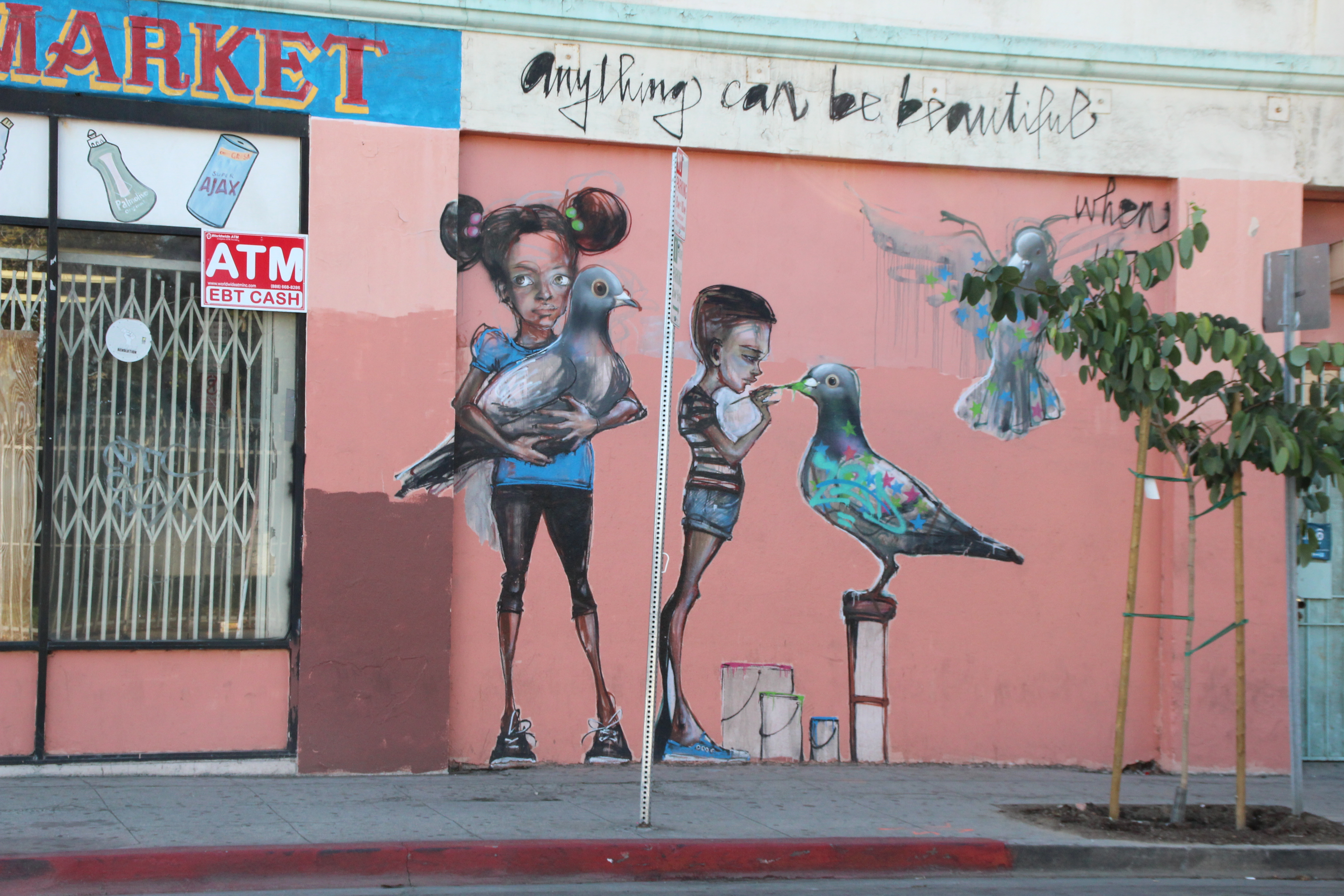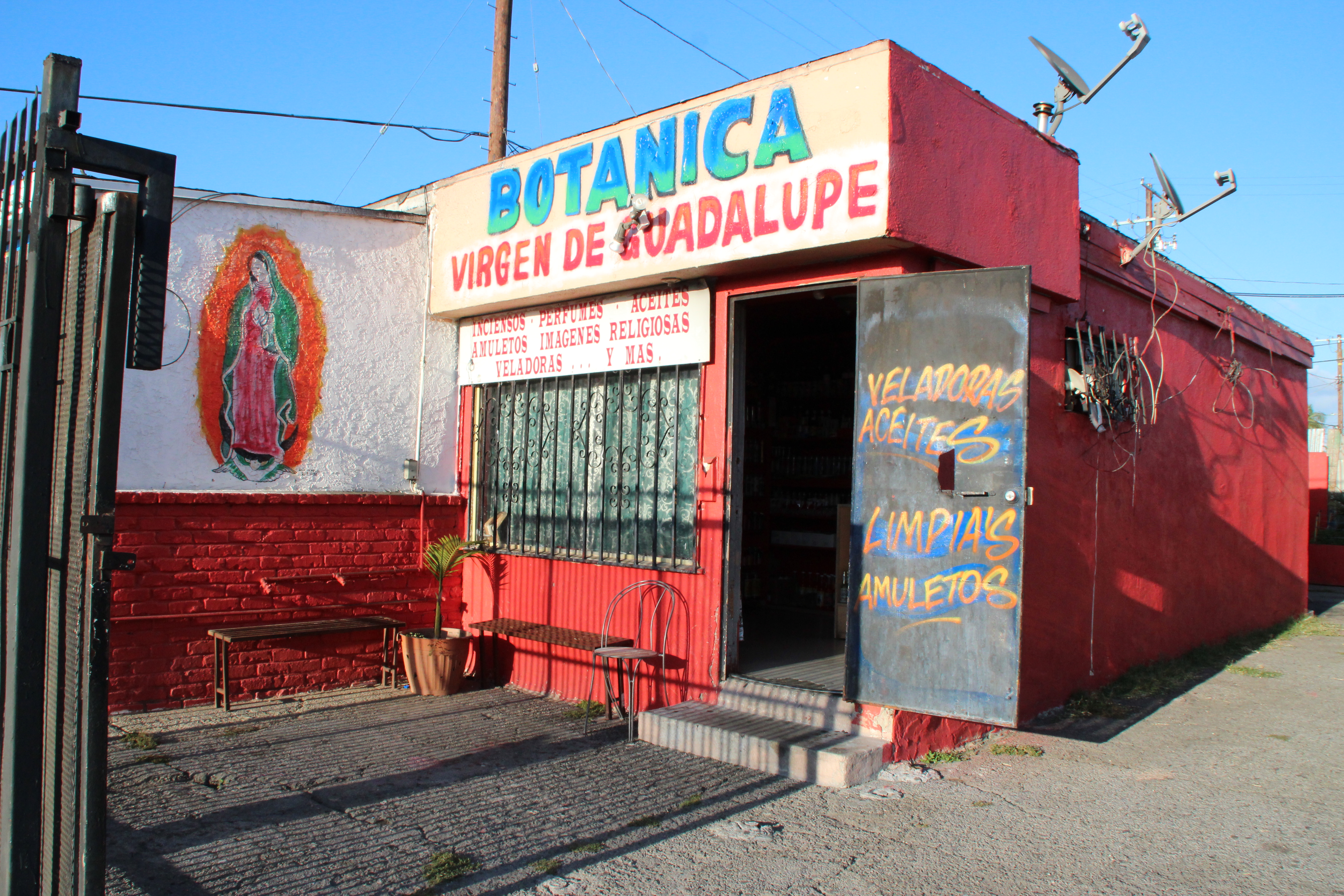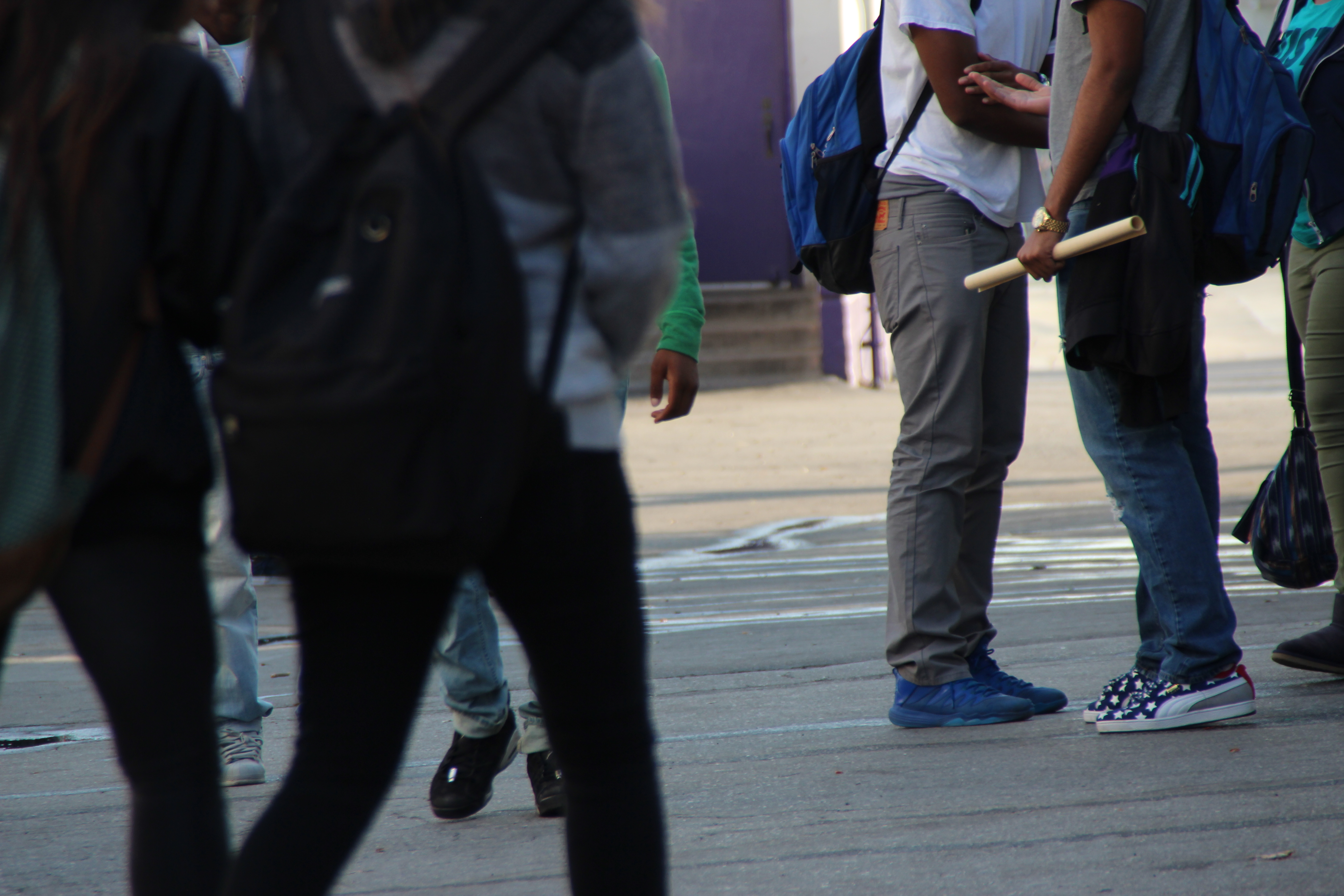Lonnie Williams
Williams, 59, grew up in Vermont Harbor, grauating from Manual Arts High School in 1975.
The generational views on race in Vermont Square.
Williams, 59, grew up in Vermont Harbor, grauating from Manual Arts High School in 1975.
Johhny cuts hair at Fresh Cuts Barber Shop in Vermont Square on Vermont Avenue.
Max is a junior at Manual Arts High School. He was born in Houston, but grew up in Los Angeles.
Elijah is an 11th grader at Manual Arts High School. He was born in Illinois, but moved to Los Angeles as a child.
Vanessa Carter is a Senior Data Analyst for USC Dornsife. She assisted in the Roots|Raices:The Shared Futures of South L.A. report.
 On the corner of Vermont and 42nd, this mural adorns the wall of a local business.
On the corner of Vermont and 42nd, this mural adorns the wall of a local business. “Hispanics vs. Blacks: The Battle For ‘Preferred Minority’ Status”
“Where black and brown collide”
“Roots of Latino/Black anger”
“The Problem With Race Wars Among Minorities”
“Do Blacks and Hispanics Get Along?”
These are just a couple of the countless headlines of stories published in the past three decades about the “new racial tension” in America between Latino and African American communities. For years now, the media has portrayed these two communities at odds, further pitting these two minority groups against one another. The media has written countless stories speculating “why such animosity exists between two ethnic groups that share so many of the same socioeconomic deprivations.”.
This “black versus brown” narrative originated in the early 90’s at the peak of the dramatic demographic revolution in South Los Angeles where Latinos were increasing in number and blacks were leaving historically African American neighborhoods like Vermont Harbor. During this period, riots ensued and racially charged violence between these two communities were at an all time high. To this day, the antiquated narrative of the violence between Black and Hispanic gangs and the fight for jobs, opportunities and resources in low-income communities continues to dominate the public’s perception of black and brown relations. But do these tensions actually still exist, nearly two decades later?
According to the Roots|Raices: Shared Futures in South L.A. study, a project conducted by USC's Center for the Study of Immigrant Integration that examines the relationship between blacks and Latinos, the answer is yes and no. Within communities like Vermont Harbor there exists a generational divide between the older and younger generation's view on race and the relationship between the African American and Latino communities. Latinos who immigrated to the U.S. in the 80's and 90's and African Americans who grew up in South L.A. when they were still predominantly black areas typically believe the racial tensions in their communities still exist, divided by language and and the racially charged crime crippling their communities. Meanwhile, millennial African Americans and second-generation Latinos that grew up together in South Los Angeles tend to feel a sense of friendship and camaraderie, bonded by the shared experiences and struggles of growing up in South Los Angeles.
In reference to the media's "black versus brown" narrative, Vanessa Carter, a senior data analyst for the Roots|Raices Report, observed, "Really it seems an overplayed narrative in terms of the media who has consistently hyped that up and even tried to use data to support it saying that... just really misrepresenting the data... So in the day-to-day, in our interviews we heard a lot of instances of friendship and accommodation and working towards each other."
There are many contributing factors that play into older generation's negative attitudes toward the African American population in their South L.A. neighborhoods. One prominent cause that contributed to this lack of common ground despite living side-by-side was the language barrier that existed when their new neighbors began to move in.
“The issue of language affected day-to-day productivity and life communication. The fact that first generation Latinos couldn't communicate with African Americans was a huge barrier to establishing long-lasting relationships,” says Walther Thompson-Hernandez. Hernandez is a former USC grad student who helped conduct the interviews in Vermont Harbor, but is now a UCLA PhD student in Chicano studies and working multimedia journalist.
A Latino resident of 35 years remembers his family’s early days in Los Angeles were very isolated. “We weren’t people of the street. We were people who went to work, the laundry, the market, and to work. Well, we would visit family (elsewhere)…but to go to the parks? You couldn’t. People just didn’t feel safe,” he reminisces.
Not only were first generation Latinos not able to communicate with their black neighbors, but many first generation Latinos like Damaris Abila’s parents held an anti-black ideology that originated from Latin America. When settling down in the racially charged violent gang culture that monopolized much of South Los Angeles, these negative stereotypes and perceptions of African Americans were only reinforced.
“For the most part, my parents are racists towards blacks… Because of the perspective they've been given from their parents and how they run into situations where it causes hatred,” says Damaris Abila, a second-generation Latina senior at Manual Arts High School, a local Vermont Harbor school.
Hernandez says many of the older Latinos negative attitudes towards African Americans were sometimes based on one bad encounter. “One negative experience has a huge impact. "Let’s say somebody got robbed or jumped or beat up by an African American. That's an experience that they would keep deep in their memory which ultimately impacted their relations for years to come,” says Hernandez.
Manueo Contreres, one of the many second-generation Latino students at Manual Arts, says that while his parents don’t have a problem with black people, they still have their reservations based on past experiences “But it gets to a certain point where some black people have crossed the line and made my parents…. I wouldn’t say hate them but have a certain opinion of them,” admits Contreres.

Bothanica is one of the countless Latino owned business that line Vermont Avenue.
Lonnie Williams, 59, and Karl Price, 54, and other African American baby boomers grew up in Vermont Square when it was still a deeply rooted African American community. Vermont Square houses, businesses, and schools were all dominated by African Americans. By the time the 90’s rolled around, the community they grew up in was unrecognizable. Sultry jazz clubs and southern food joins were replaced by Latin dance clubs and Centro Americano panaderias.
"The Spanish are taking over. Back in the days, in the '60s and '70s, there was a lot of blacks. But if you go over there today, you're not going to see those black owned businesses anymore," said Williams.
Williams believes that Latinos are to blame for the shrinking black community in neighborhoods like Vermont Square. “They’re being pushed out I’m telling you. They’re being pushed out because the Spanish are coming. There are not that many black-owned businesses around here, you got the Spanish stores popping up, Spanish business and blacks, you know, Spanish talk crazy to them and they don’t want to hear this shit.”
However, this sentiment towards Latinos is held by many older African Americans, according to Hernandez. “We found that this sort of general feeling that Latinos came in and took black jobs and have really sort of like played into the social and physical eviction of African Americans in South L.A.”
Williams believes that the racial tension that reached its peak in the 90’s still continues to persist today. “They say these Mexicans, or whatever you call them or wherever they come from, you know, they be talking about us blacks. They say the stuff in Spanish, so we don’t understand. And they said we don’t understand. But a lot of blacks, you know, they can’t stand that Spanish man. I’m not going to lie to you. They can’t stand them.”
Karl Price, a retired Los Angeles County mechanic born and raised in Los Angeles, believes that Latinos hold similar racial sentiments towards blacks as well. "It went from all black to all Hispanic. It's all Hispanic over here now. It's like us blacks, we got our own little area, the 'Black hole'. The Latin’s, they are the most racist people you will ever meet, especially Mexicans. They don't like nobody. They just mess with their own people."

Latino and Black students stay back after school to hang out with friends in the Manual Arts High School courtyard.
While much more subdued, this African American view on the Latinos' tendency to keep to themselves trickles down to younger generations.Many black students have mixed feelings about the relationship between Latino and Black students at Manual Arts. Among the black student body, there is a range of opinions on whether racial tensions still persist in their student body.
"Latino kids... they most likely keep to themselves. it's not like they're racist its just that they're more comfortable talking to people within their race. Like there are some maybe like 50 percent of the Hispanic population who hangs out with African Americans at Manual Arts," says Elijah McCloud, an 11th grader at Manual Arts.
Meanwhile, Mesean Green, a 10th grader at Manual Arts, believes that these tensions no longer exist. “I don't feel like it's a problem. It's all cool. At the end of the day we're all the same, we’re all students. So it doesn't really matter."
On the polar opposite side of the spectrum, students like Alliah Smith and Cherice Jackson believe that race continues to be a huge problem at Manual Arts.
“I think everyone is angry and mad. Everyone just wants to fight each other,” observes Smith.
However, according to McCloud, it’s somewhere in between. “I wouldn't say its neutral. I would say there's definitely tension,” he says. “At Manual Arts it's not like you have to pick a side. But if you're Hispanic and you try to hang out with the African Americans here, I doubt they will receive you back,” observes McCloud.
While there is not one overwhelming opinion on whether racial tensions still exist in Vermont Square, many black Manual Arts students agree that if there is any prejudice, it arises from stereotypes.
While many African American students believe that racial tensions still persist in their student body, Latino students feel that the conflicts between students are more personal than racial.
"We don't really have a problem, it's really under the radar. There are some Hispanics here that don't get along with blacks and blacks who don't get along with Hispanics. But just for personal reasons too," observes Max Isidoro, a sophomore at Manual Arts.
According to Hernandez, this sense of camaraderie that Latinos feel towards their African American classmates despite their parents’ racial opinions is a result of growing up with a “black consciousness.”
"Younger Latinos were able to decontextualize the negative stigmas that they learned about black people and were able to understand that one negative experience with an African American doesn't speak for an entire community and population."
Growing up with black friends, classmates, and significant others, many of the Manual Arts second-generation students do not only feel that the issue of race is obsolete, but their status as minorities in America, especially in South L.A., unifies the two communities.
"I think we all see each other as equals. I don't think any of the students here see color, just because in America, we're all considered people of color, and we're all in that same category, so we don't really categorize each other," Alba points out.
Overall, it’s hard to define the current state of race relations between the Latino and African-American communities. The relationship between African-Americans and Hispanics in Vermont Square and other South L.A. neighborhoods are more nuanced and complex than the reductive lens through which the media portrays it. Hernandez, a journalist himself, admits that the media has a huge part in perpetuating this simple narrative.
If there's one thing the Manual Arts High School students can agree on, it's that the news they see about their neighborhood, have negative effects on the community itself. McCloud thinks that these kinds of stories have a huge influence on Vermont Square resident's perception on their African American or Latino neighbors, perpetuating the "black versus brown" narrative.
"I feel like if someone took the time to read L.A. Times or anything like that and it's showing African Americans in a bad way then the next Hispanic person is going to look at us with fear and take the wrong type of action. Even as an African American, if you see a Hispanic did this or that then the black person is going to take precaution and may make a mistake because of someone else's report that may not be the truth," says McCloud
Isidoro agreed with McCloud and added that overall, the media has created a negative, criminalized image of their community that just isn't true.
"I feel like what I see on the news, it's really sad because they don't really live here and they don't see what's actually going on. They only know what's like going to get the people's attention. Whenever you see us doing something together, they're like, 'Oh they're doing that in the Valley or they're doing that somewhere else, so it's nothing new.' But whenever they see crime, they're like, 'Oh that's interesting.' So that's why we're always getting put down because they're always doing criminal activity. That's how they'll always see us as criminals because that's the only thing they see on the news. They never see us as successful people because they never put things that we're doing that are successful for us. That's the stereotype. Like oh yeah, don't go to South central, it's dangerous down there, they're always having shootings and everything. Like if you were to actually live out here, you would know that that's not actually true."
One thing that is clear to everyone in this community, is that the news reported by mainstream media has done an injustice not only to Vermont Harbor, but other South Central neighborhoods.
"We are framing blacks and Latinos at odds and sort of creating these stories and situations that aren't necessarily false but aren't necessarily true and it impacts the community. We have created situations where people are dehumanized and they're day-to-day experiences aren't validated and aren't represented," says Hernandez.
Here are 65 stories written about Vermont Harbor since 2012. Of the 65, 45 stories were on crime, 11 on the community, 1 on education and 9 on metro. Click on the icons to get more information and links to the online story.